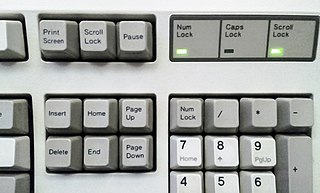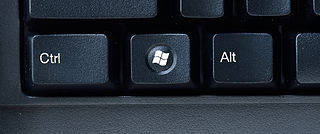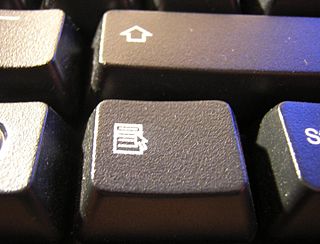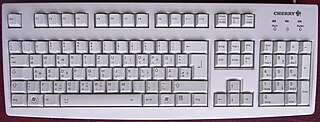Related Research Articles
The Break key of a computer keyboard refers to breaking a telegraph circuit and originated with 19th century practice. In modern usage, the key has no well-defined purpose, but while this is the case, it can be used by software for miscellaneous tasks, such as to switch between multiple login sessions, to terminate a program, or to interrupt a modem connection.

A context menu is a menu in a graphical user interface (GUI) that appears upon user interaction, such as a right-click mouse operation. A context menu offers a limited set of choices that are available in the current state, or context, of the operating system or application to which the menu belongs. Usually the available choices are actions related to the selected object. From a technical point of view, such a context menu is a graphical control element.
The keyboard for IBM PC-compatible computers is standardized. However, during the more than 30 years of PC architecture being frequently updated, many keyboard layout variations have been developed.

Scroll Lock is a lock key on most IBM-compatible computer keyboards. Depending on the operating system, it may be used for different purposes, and applications may assign functions to the key or change their behavior depending on its toggling state. The key is not frequently used, and therefore some reduced or specialized keyboards lack Scroll Lock altogether.
System Request is a key on personal computer keyboards that has no standard use. Introduced by IBM with the PC/AT, it was intended to be available as a special key to directly invoke low-level operating system functions with no possibility of conflicting with any existing software. A special BIOS routine – software interrupt 0x15, subfunction 0x85 – was added to signal the OS when SysRq was pushed or released. Unlike most keys, when it is pressed nothing is stored in the keyboard buffer.

WordStar is a word processor application for microcomputers. It was published by MicroPro International and originally written for the CP/M-80 operating system, with later editions added for MS-DOS and other 16-bit PC OSes. Rob Barnaby was the sole author of the early versions of the program.

In computing, a Control keyCtrl is a modifier key which, when pressed in conjunction with another key, performs a special operation. Similarly to the Shift key, the Control key rarely performs any function when pressed by itself. The Control key is located on or near the bottom left side of most keyboards, with many featuring an additional one at the bottom right.

A function key is a key on a computer or terminal keyboard that can be programmed to cause the operating system or an application program to perform certain actions, a form of soft key. On some keyboards/computers, function keys may have default actions, accessible on power-on.

In computing, a keyboard shortcut also known as hotkey is a series of one or several keys to quickly invoke a software program or perform a preprogrammed action. This action may be part of the standard functionality of the operating system or application program, or it may have been written by the user in a scripting language. Some integrated keyboards also include pointing devices; the definition of exactly what counts as a "key" sometimes differs.

The Windows logo key is a keyboard key which was originally introduced on Microsoft's Natural Keyboard in 1994. This key became a standard key on PC keyboards. In Windows, pressing the key brings up the start menu. Ctrl+Esc performs the same function, in case the keyboard lacks this key.
Common User Access (CUA) is a standard for user interfaces to operating systems and computer programs. It was developed by IBM and first published in 1987 as part of their Systems Application Architecture. Used originally in the MVS/ESA, VM/CMS, OS/400, OS/2 and Microsoft Windows operating systems, parts of the CUA standard are now implemented in programs for other operating systems, including variants of Unix. It is also used by Java AWT and Swing.
Print Screen is a key present on most PC keyboards. It is typically situated in the same section as the break key and scroll lock key. The print screen may share the same key as system request.

Arrow keys or cursor movement keys are keys on a computer keyboard that are either programmed or designated to move the cursor in a specified direction.

In computing, the menu key, or application key, is a key previously found on Microsoft Windows-oriented computer keyboards. It was introduced at the same time as the Windows logo key. On keyboards including the key, its symbol would usually have been a small icon depicting a pointer hovering above a menu; it would typically have been found on the right side of the keyboard between the right Windows logo key and the right control key. While the Windows key is present on the vast majority of keyboards intended for use with the Windows operating system, the menu key was frequently omitted in the interest of space, particularly on portable and laptop keyboards.

On computer keyboards, the Esc keyEsc is a key used to generate the escape character. The escape character, when sent from the keyboard to a computer, often is interpreted by software as "stop", "cancel" or "exit", and when sent from the computer to an external device marks the beginning of an escape sequence to specify operating modes or characteristics generally.
The Windows shell is the graphical user interface for the Microsoft Windows operating system. Its readily identifiable elements consist of the desktop, the taskbar, the Start menu, the task switcher and the AutoPlay feature. On some versions of Windows, it also includes Flip 3D and the charms. In Windows 10, the Windows Shell Experience Host interface drives visuals like the Start Menu, Action Center, Taskbar, and Task View/Timeline. However, the Windows shell also implements a shell namespace that enables computer programs running on Windows to access the computer's resources via the hierarchy of shell objects. "Desktop" is the top object of the hierarchy; below it there are a number of files and folders stored on the disk, as well as a number of special folders whose contents are either virtual or dynamically created. Recycle Bin, Libraries, Control Panel, This PC and Network are examples of such shell objects.
In computing, a keyboard shortcut is a sequence or combination of keystrokes on a computer keyboard which invokes commands in software.

Solitaire is a computer game included with Microsoft Windows, based on a card game of the same name, also known as Klondike. Its original version was programmed by Wes Cherry, and the cards were designed by Susan Kare.

A computer keyboard is a peripheral input device modeled after the typewriter keyboard which uses an arrangement of buttons or keys to act as mechanical levers or electronic switches. Replacing early punched cards and paper tape technology, interaction via teleprinter-style keyboards have been the main input method for computers since the 1970s, supplemented by the computer mouse since the 1980s.
Control-Alt-Delete is a computer keyboard command on IBM PC compatible computers, invoked by pressing the Delete key while holding the Control and Alt keys: Ctrl+Alt+Delete. The function of the key combination differs depending on the context but it generally interrupts or facilitates interrupting a function. For instance, in pre-boot environment or in MS-DOS, Windows 3.0 and earlier versions of Windows or OS/2, the key combination reboots the computer. Starting with Windows 95, the key combination invokes a task manager or security related component that facilitates ending a Windows session or killing a frozen application.
References
- ↑ "While the Boss Is Away . . ". New York Times . May 14, 1989. Retrieved January 3, 2023.
- ↑ "FriendlyWare P.C. Arcade" . Retrieved October 9, 2009.
- ↑ Hubert B. Herring (February 11, 1999). "A Site for Venting". New York Times . Retrieved January 3, 2022.
- ↑ "Home". rogerwagner.com. Retrieved February 18, 2017.
- ↑ "Home". rogerwagner.com. Retrieved February 18, 2017.
- ↑ "B3TA : INTERVIEWS: Wes Cherry". B3TA. Retrieved June 15, 2020.
- ↑ Warren, Tom (May 22, 2020). "Microsoft Solitaire turns 30 years old today and still has 35 million monthly players". The Verge . Retrieved May 24, 2020.
- ↑ Van Gelder, Lindsay (December 1982). "Superplayers Run The Gauntlet". PC Magazine . p. 131. Retrieved January 18, 2015.
- ↑ "A New Game Package is Introduced for Windows". New York Times . July 7, 1993. Retrieved January 3, 2023.
- ↑ "'Boss Button' making it easier to watch NCAA at work". Archived from the original on November 3, 2016. Retrieved March 21, 2014.
- ↑ Bobby Burch (February 7, 2014). "How to watch the Olympics at work without getting caught". BizJournals.com (Kansas City). Retrieved January 3, 2023.